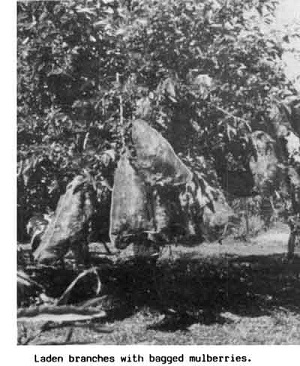From the Archives
of the Rare Fruit Council of Australia
by Christine Gray

Making Use of
the Mulberry
Scientific
name: Morus species
Family:
Moraceae
One tree which is taken for granted in our orchard is the Mulberry.
Lately I have been looking after the Mulberry and enjoying the fruits
of my labour.

Last
September, I gathered boxes of fruit and made the fruit into jam and a
refreshing mulberry drink. The birds, especially starlings feast on the
fruit and usually we only pick a handful of fruit. Last Spring, that is
when the mulberry is in full fruit, I took the time to cover the fruit
with bags. I acquired several onion and orange bags, cut one section
out of each bottom of the bags and fastened with a peg. I slipped the
bag over laden branches and then secured by tying with a string. Every
second day during ripening of the fruit I held a box at the end of each
covered branch, took off the peg, tapped the branch and all the ripe
fruit fell into the bag. I then shook the bag till all the fruit
emptied into the box.
It is better not to put too many mulberries to a box as they tend to
squash. Squashed fruit is okay for jam though.
My
recipe for making mulberry jam is: boil fruit for ½ hour (no
water needed) stirring occasionally. Then take off stove. Measure one
cup of sugar to one cup of pulp, add 2 teaspoons of vinegar to each 1
cup of fruit plus sugar mixture.
Put on stove and boil and stir for ½ hour. Put into hot, sterilised
jars (the vinegar helps it to set and stops mould).
I
also made a fresh drink with the mulberries. Place a colander over a
bowl. Add mulberries and squash fruit with a jar until all juice is
gone and strained into bowl. Add 50% water to juice, 5% sugar syrup,
and 4% lime juice. Serve cold or freeze for later use.
One thing
about using mulberries is that your hands turn purple. I tried
everything to remove the stain. I remembered I kept an article from
1977 from "Your Garden" magazine and there it was - the answer. Use the
juice of green mulberries to remove stains on hands etc. I collected
some green mulberries, rubbed the juice into my hands and instantly the
stains disappeared. (Nature is sure fascinating.)
The mulberry,
according to "Your Garden" originates from Persia, now Iran. It is
related to the fig and breadfruit and is of the Moraceae family.
For pruning, it is only necessary to thin crowded wood and cut back by
half any long spindly branches.
Once
we had a mulberry tree and cropped it back 5 ft from the ground. It
died! So it is important to keep lots of leaves on the tree.
The
mulberry is hardy, but loves to be fed with mulch and fertilizer,
organic or artificial. Just a bit more attention to the mulberry can
make it a very rewarding tree in your home garden.
Back to
Mulberry Page
|
|

